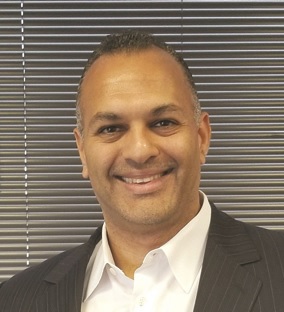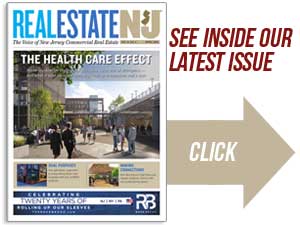Clockwise, from top left: Chris Paladino, president of New Brunswick Development Corp.; Mark Manigan, CEO and president of RWJBarnabas Health; Wasseem Boraie, partner with Boraie Development; and Tony Coscia, partner with Windels Marx, discuss New Brunswick’s revival during a panel discussion on Nov. 13 at the Heldrich Hotel & Conference Center. — All photos by Aaron Houston for Real Estate NJ
By Joshua Burd
For every advantage that New Brunswick has, its strength may well be rooted in its size.
At only about five square miles, it’s far from New Jersey’s largest city. But developers say that scale has provided a manageable starting point for the municipality’s growth in recent decades, allowing it to harness the vast resources of business, academic and political leaders that are often available in other urban centers but are not leveraged as successfully.

“We have a lot of the same institutions,” said Chris Paladino, president of New Brunswick Development Corp., or Devco. “We just have it in a much more condensed critical mass.”
Capitalizing on those assets has been a hallmark of New Brunswick’s economic revival over the past 30 to 40 years, a stretch that has seen billions of dollars in redevelopment. Paladino and other key industry figures said as much last week at an event hosted by Real Estate NJ, as they discussed the philosophical and financial partnerships behind the city’s largest public- and private-sector development projects.
“From our perspective, there are not a lot of cities in the state that are like New Brunswick,” said Wasseem Boraie, a partner with Boraie Development, pointing to the expectations that come with having strong anchor institutions and consistency in municipal government.

Boraie, whose firm is based in the city, said those institutions provide “a sense of determinism” and a set of long-term goals that private developers must reflect. That has informed the company’s investments since his father began buying property in New Brunswick in the 1970s and in the downtown in the 1980s, paving the way for its two Albany Street Plaza office towers built in 1988 and 2004, along with two major residential projects — including One Spring Street, a collection of 121 condos delivered in 2007, and a 238-unit luxury apartment high-rise known as The Aspire that opened in 2015.
“You have pillars that, as an investor, you can depend on,” said Boraie, whose firm is now planning a 30-story, 342-unit rental tower at 11 Spring St. as its next project in the city. “So when you look at New Brunswick, the thing that’s made it work from our perspective is that, when you come to the city with a deal, the city has the sophistication to almost be a part of your deal without actually being in your deal. And a lot of other cities aren’t like that.”
Paladino and Boraie joined Tony Coscia of Windels Marx and Mark Manigan of RWJBarnabas Health as panelists for the Nov. 13 event, speaking to a packed house at the Heldrich Hotel & Conference Center on Livingston Avenue. Paul V. Profeta, publisher of Real Estate NJ, and Josh Burd, the publication’s editor, moderated the program.

Key anchors in government, academia and health care will be central to some of the other high-profile projects that are still to come. Devco is spearheading the new Health + Life Science Exchange or HELIX project, whose first phase is under construction on Albany Street and will feature more than 570,000 square feet of incubator and research space, a new home for the Rutgers Robert Wood Johnson Medical School and a center for what’s known as translational research. The not-for-profit developer is also roughly 18 months from delivering the $900 million Jack and Sheryl Morris Cancer Center, which will span 520,000 square feet of modern treatment, patient services and research space at Somerset and Division streets under a partnership that includes RWJBarnabas Health and the Rutgers Cancer Institute.
“The other thing that makes New Brunswick very attractive is that it’s all about workforce,” said Paladino, whose firm is planning a second phase of the HELIX in tandem with SJP Properties. “I’ve never been in a discussion with a potential client that didn’t include HR, and it’s ‘Can they get people to come here to work? Can they recruit them?’
“And with a number of the folks that we are having very serious conversations with, it’s about being able to recruit from Rutgers and Princeton the next generation of biologists and electrical engineers and computers scientists, so we’re very fortunate.”
SLIDESHOW: The New Brunswick Redevelopment Story
Manigan, CEO and president of RWJBarnabas Health, said the freestanding cancer center is “a pretty pure example of our strategy to create a statewide system of care and reimagine where that care is being provided.” Expanding its physical footprint will help fill several needs for the system, including the creation of the state’s first standalone cancer hospital and doubling down on oncology research.
The same goes for RWJBarnabas’ other facilities in the city, from a new medical arts building to its flagship Robert Wood Johnson University Hospital.

“This is the flywheel we’re trying to create, where we’re bringing together real estate development that is sexy and appealing to the clinicians you want to have working at your clinics, training your doctors, innovating and inventing,” Manigan said. “When they come into town and they see what we’re doing, the investments we’re making and the success we’ve had in growing and attracting talent, that’s what we’re doing here.”
He added: “Having a state-of-the-art real estate program is essential to that and that’s why we were comfortable making a significant investment.”
The HELIX and the cancer center are among the latest projects by Devco, a development entity established by Johnson & Johnson in the mid-1970s. Typically, its projects involve an eclectic layering of funding sources from government, private capital and everything in between — from obscure federal tax credits and parking authority bonds to bank loans and state incentive programs — creating a formula that has supported its $3.5 billion in completed development over the past three decades.
That has included transformative projects such as a mixed-use, $172 million performing arts complex that opened in 2019 and the $143 million Gateway transit village, which brought 192 residential units and a new Barnes & Noble Rutgers University bookstore to the heart of the downtown in 2011.

“All of these are ways of trying to fund a project that on its own isn’t really viable economically, but has a very broad public purpose that could be served by completing it,” said Coscia, a partner with Windels Marx and Devco’s longtime counsel. “So all of these different programs are used to piece together a transaction that takes a project that in and of itself might not be economically viable and making it viable.
Coscia added that, “as complicated as these transactions have been and as creative as we’ve had to be, execution is impossible unless you have the people who are there that can actually execute.” He said Paladino “deserves an enormous amount of credit for the painstaking work of executing on things that are complicated,” while adding that New Brunswick Mayor James Cahill has brought consistency and practicality to the process during 30-plus years in office.
“The fact that New Brunswick has the kind of leadership on the governmental level that makes it that kind of partner is a world of difference,” Coscia said. “Jim Cahill is an urban mayor like very few urban mayors. He gets it, he’s smart … it’s not about who gets to be out front, meaning who gets the credit, but who takes the time to understand it.
“The combination of Chris and the mayor (is) really why these things get built.”

The city’s development pipeline remains full. Boraie’s apartment tower at 11 Spring St. is among several private-sector projects that could go vertical in the coming years, while Devco and SJP are actively marketing the second phase of the HELIX that would include 600,000 square feet of build-to-suit lab and office space.
The latter, which would represent another nearly $2 billion in investment, will highlight a continued need for housing in New Brunswick as so many large projects come online.
“We’re talking about hundreds and hundreds of people coming to H-2,” Paladino said, referring to HELIX phase two. “They’ve got to live somewhere.”
That’s not to mention the estimated 1,600 jobs that the project’s first phase will produce and the roughly 600 people that will work at the new cancer hospital starting in spring 2025.
“This may be one of the strange microcosms that is countercyclical to the rest of the state,” Paladino said. “We need to build housing, because I’d say that most of the housing is filled here in New Brunswick.”











